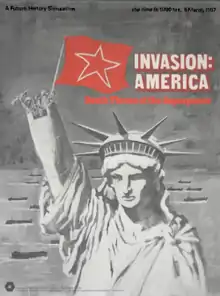Invasion America (board wargame)
Invasion: America, subtitled "Death Throes of the Superpower", is a near-future board wargame published by SPI in 1976 that simulates a hypothetical coordinated attack on North America by various factions.

Description
In this alternate history, it is the year 2000, and the United States has annexed Mexico and the states of Central America. Invasion: America is a 2–4 player corps-level wargame in which one side controls a coalition of three factions simultaneously invading North America from the Pacific, South America and Cuba, and the other side defends North America with American and Canadian forces.[1]
Components
The game box contains:[2]
- two-piece 35" x 46" paper hex grid map of North America scaled at 130 km (80 mi) per hex
- 400 die-cut counters
- 16-page rule book
- plastic counter tray
- two six-sided dice
Scenarios
There are six scenarios presented with the game that each last 8 turns. There is also a 60-turn campaign game.[1]
Gameplay
The game uses the standard "I go, You go" system: one player moves all pieces desired, then the other player moves. If, after a player's movement phase, any units are adjacent to an enemy piece, combat is resolved by calculating the ratio of attacker to defender strength and rolling a die. The result is losses or a forced retreat for one or both sides.[1]
Untried units
Invasion: America was the first wargame to use the concept of "untried units" to extend a fog of war over the map.[3] Each militia unit has its true value printed on one side and a question mark printed on the other side. The counter is placed facedown with the question mark showing. The players do not know the strength of a unit until it is engaged and subsequently flipped over. If militia units show zero combat strength they will retreat, as will ALL other units in their stack.[4]
Victory conditions
In each of the scenarios, control of important cities and resources results in victory points -- the side with the most points at the end of the 8th turn wins. In the campaign game, the invaders must control all cities and resources by the end of the 60th turn to win; otherwise the North American side wins.[1]
Publication history
Invasion: America was designed by Jim Dunnigan, with cover art and graphics design by Redmond A. Simonsen. When it was released by SPI in early 1976, it immediately rose to #1 on SPI's Top Ten Bestsller List, and remained in the Top Ten for the remainder of the year.[5]
In 1978, SPI released a larger sequel, Objective Moscow, in which the tables are turned and the Soviet Union is invaded by a coalition composed of NATO, China and Iran.[2]
Reception
In his 1977 book The Comprehensive Guide to Board Wargaming, Nicholas Palmer noted, "The hypothesis is fanciful, but it gives an excellent excuse for a modern war fought over a giant multi-coloured map of the continent." Palmer liked the shorter scenarios, saying, "the scenarios have fewer turns than most complex games, so they can be played in 4–6 hours." He noted "Some problems with play balance, as the defence (realistically enough) can maintain almost permanent air superiority by basing their planes well inland." Palmer concluded "The total effect is colourful, complex, and naturally rather abstract."[6]
In Issue 16 of The Space Gamer, Tony Van Lien commented that "For those of us who are into holocaust, Invasion: America, by Simulations Publications Inc. is the game we've been waiting for." He called the then-new "untried unit" rule "a simple and very playable system that adds greatly to the feel of the fog of war in the game." Although Van Lien liked the simplicity of the rules, he was disappointed that there was no scenario that involved an invasion force crossing the Bering Strait. He also thought the actual physical size of the map and the large number of counters might be off-putting to a new gamer. Despite these faults, Van Lien concluded on a positive note, saying, ""I:A has appeal for experienced gamers as well as newcomers. It's a truly great game."[2]
In the inaugural issue of Ares (March 1980), Eric Goldberg liked the "beautiful" map, and commented that "for a large game, [it] plays quite well." But Goldberg found that "There are serious problems in the scenario victory conditions and some of the miscellaneous rules." He concluded by giving the game a below-average rating of 6 out of 9, saying, "the game is not one this writer would play more than once. There was enough interest in the system, however, to do a game in which the Soviet Union got the same treatment (Objective: Moscow)."[7]
Other reviews and commentary
- Moves #61
- Fire & Movement #74
- The Wargamer Vol.1 #1
- JagdPanther #13
- Outposts #10
- Strategist #184 & #345
- Simulacrum #11
- Phoenix #7
- Panzerschreck #10
- The Complete Book of Wargames
See also
- Fortress America - a plastic figure and area movement wargame with a similar theme.
References
- Kosnett, Phil (March–April 1978). "Invasion: America". Strategy & Tactics. No. 56. pp. 25–30.
- Van Lien, Tony (March–April 1978). "Invasion: America - a review". The Space Gamer. Metagaming (16): 29.
- Kosnett, Phil (June–July 1977). "Science Fiction Games in Print". Moves. No. 33. p. 16.
{{cite magazine}}: CS1 maint: date format (link) - Rules of Invasion America, pp. 8, sec. 16.32, - SPI 1976
- "Invasion: America – Death Throes of the Superpower (1976)". boardgamegeek.com. Retrieved 2022-02-27.
- Palmer, Nicholas (1977). The Comprehensive Guide to Board Wargaming. London: Sphere Books. p. 154.
- Goldberg, Eric (March 1980). "A Galaxy of Games". Ares Magazine. Simulations Publications, Inc. (1): 29.